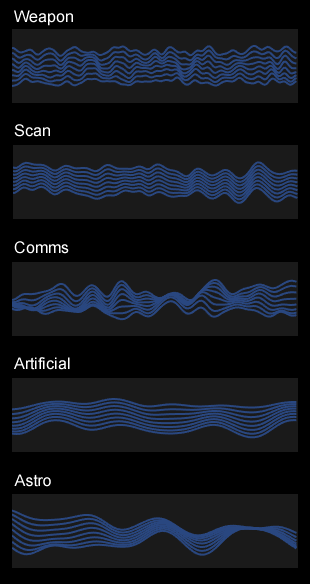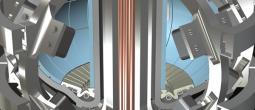

Peak Frequency Analysis

Frequency analysis involves the assessment of passively detected EM radiation to provide insights into its function and purpose.
Algorithms provide programmatically-generated assessment of a detection's most probable function.
Frequency analysis only includes incidental detections and automatically filters out known background EM such as from another vessel's engines or from Astronomical Objects (AO).
Peak Frequency Analysis
Peak frequency analysis adds additional guidance on the direction of the EM source as well the extent to which the EM may have been targeted at the vessel, based on an assessment of the detection's peak strength and dissipation patterns.
Console Panel
Peak frequency analysis is monitored from the SC-FRQ01 Peak Frequency Analysis panel.
Frequency Analysis Classes
 Functional assessments fall within one of five broad classes.
Functional assessments fall within one of five broad classes.
Where possible within each class a more specific analysis is provided via an analysis code.
Weapon
This indicates that the detection has been discharged by a weapons system.
Weapons detections typically maximise frequency shifts within a tightly-defined amplitude range.
Analysis Codes
Beam Weapon: The detection has the characteristics of a beam weapon.
Particle Weapon: The detection has the characteristics of a particle weapon. High intensity particle streams exhibit wave-like characteristics that appear similar to EM radiation.
EM Pulse: EM pulses may be used for tactical purposes if of sufficient intensity.
Scan
The indicates the detection originated from an active sensor system as a scan.
Scans typically exhibit slight variation in frequency which is consistent between frequency groups within a well-defined but lower amplitude range.
Analysis Codes
High Energy Scan (Hi Scan): Very-high frequency scans at the upper limits of the ultraviolet or lower reaches of the ionising EM bands. These types of scans are typically intended to penetrate the exterior of the scan target to provide interior detail. They do not typically cause damage when exposure is limited, but can appear similar to low-intensity weapons fire.
Low Energy Scan (Lo Scan): Significantly lower frequency scans (typically ranging between the infrared and radio EM bands) that are intended to provide reflective and/or refractive data.
Comms
This indicates the the detection is part of a communications transmission.
Comms detections are clearly modulated and show more complex variation in amplitude and/or frequency (depending on the type of modulation). Overall amplitude is typically lower than for scans.
Comms detections are typically in the radio EM band although can be found in the lower infrared band. As available bandwidth is determined by frequency, higher frequency detections indicate more complex data,
Analysis Codes
Visual: Modulation and frequency indicates the detection is primarily a visual transmission.
Audio: Modulation and frequency indicate the detection is primarily an audio-only transmission.
Data: Modulation and frequency indicate data-only transmission.
Artificial
This indicates that the detection does not have any specific functional characteristics although discernable patterns within the detection suggest an artificial source.
Artificial detections typically exhibit broad variations in frequency but the variation is more consistent between frequency groups, with less variation in amplitude than natural/astronomical sources (see below).
Most artificial EM detections would be filtered out by frequency analysis unless they were exotic or unknown and not associated with an EMDAR contact. Examples would include EM radiation generated as a by-product of the operation of unknown/exoctic propulsion systems, power generation equipment or field generators.
Analysis Codes
EM Pulse: Artificial EM pulses are generated by a number of conditions, including exploding ordnance or equipment.
Propulsion: Ambient EM generated as a by-product of operating an unknown propulsion system not already associated with an EMDAR contact.
Power: Ambient EM generated as a by-product of an unknown power generation system not already associated with an EMDAR contact.
Field: A distributed EM field that could potentially be orchestrated as a detection, deflector or force field not already associated with an EMDAR contact.
Astro
This indicates that the detection as a natural (likely astronomical) source. Most astronomical EM is filtered out by sensor systems so a detection would only be indicated if the characteristics were unusual.
Astronomical detections typically exhibit broad variations in frequency (with minimal consistency between frequency groups) and amplitude.
Analysis Codes
EM Pulse: Can be generated by a number of astronomical conditions or phenomena.
Stellar: EM emissions from stars that are unusual due to their intensity (such as flares) or otherwise uncharacteristic.
Background (Bgnd): Background EM radiation that is uncharacteristic due to its location (eg lacking any obvious source) or intensity.








